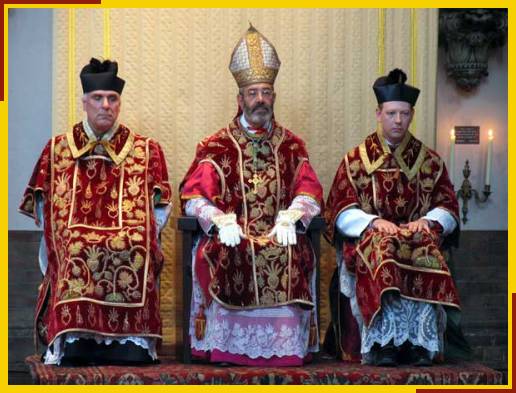Leonine Prayers
Now here is a bizarre coincident. The following prayers are the Prayers after Low Mass which were prescribed by Pope Leo XIII. Pope Leo (well known to Anglicans as the author of Apostolicae Curae) composed the Prayer to Saint Michael the Archangel. These prayers were reinforced by Pope Pius XI and Pope Pius XII.
Until Vatican II these prayers were in general use. A decade later, Pope Paul VI said, "satan has entered the sanctuary." Could the elimination of these powerful prayers with a ten year indulgence have played a huge part in allowing the devil such easy access?
Until Vatican II these prayers were in general use. A decade later, Pope Paul VI said, "satan has entered the sanctuary." Could the elimination of these powerful prayers with a ten year indulgence have played a huge part in allowing the devil such easy access?
Hail Mary, full of grace, the Lord is with thee; blessed art thou amongst women, and blessed is the fruit of thy womb, Jesus. Holy Mary, Mother of God, pray for us sinners, now and at the hour of our death. Amen. (Said 3 times)
Hail, Holy Queen, Mother of Mercy, our life, our sweetness, and our hope. To thee to we cry, poor banished children of Eve. To thee do we send up our sighs, mouring and weeping in this valley of tears. Turn then, most gracious advocate, thine eyes of mercy toward us, and after this exile, show unto us the blessed Fruit of thy womb, Jesus. O clement, O loving, O sweet Virgin Mary.
Pray for us, O holy Mother of God.
That we may be made worthy of the promises of Christ.
Let us pray.
O God, our refuge and our strength, look down with mercy upon the people who cry to Thee; and by the intercession of the glorious and immaculate Virgin Mary, Mother of God, of Saint Joseph her spouse, of the blessed Apostles Peter and Paul, and of all the saints, in Thy mercy and goodness hear our prayers for the conversion of sinners, and for the liberty and exaltation of the Holy Mother the Church. Through the same Christ Our Lord.
Amen.
Saint Michael the Archangel, defend us in battle; be our protection against the wickedness and snares of the devil. May God rebuke him, we humbly pray: and do thou, O Prince of the heavenly host, by the power of God, thrust into hell satan and all the evil spirits who prowl about the world seeking the ruin of souls.
Amen.
Most Sacred Heart of Jesus,
Have mercy on us.
Most Sacred Heart of Jesus,
Have mercy on us.
Most Sacred Heart of Jesus,
Have mercy on us.

